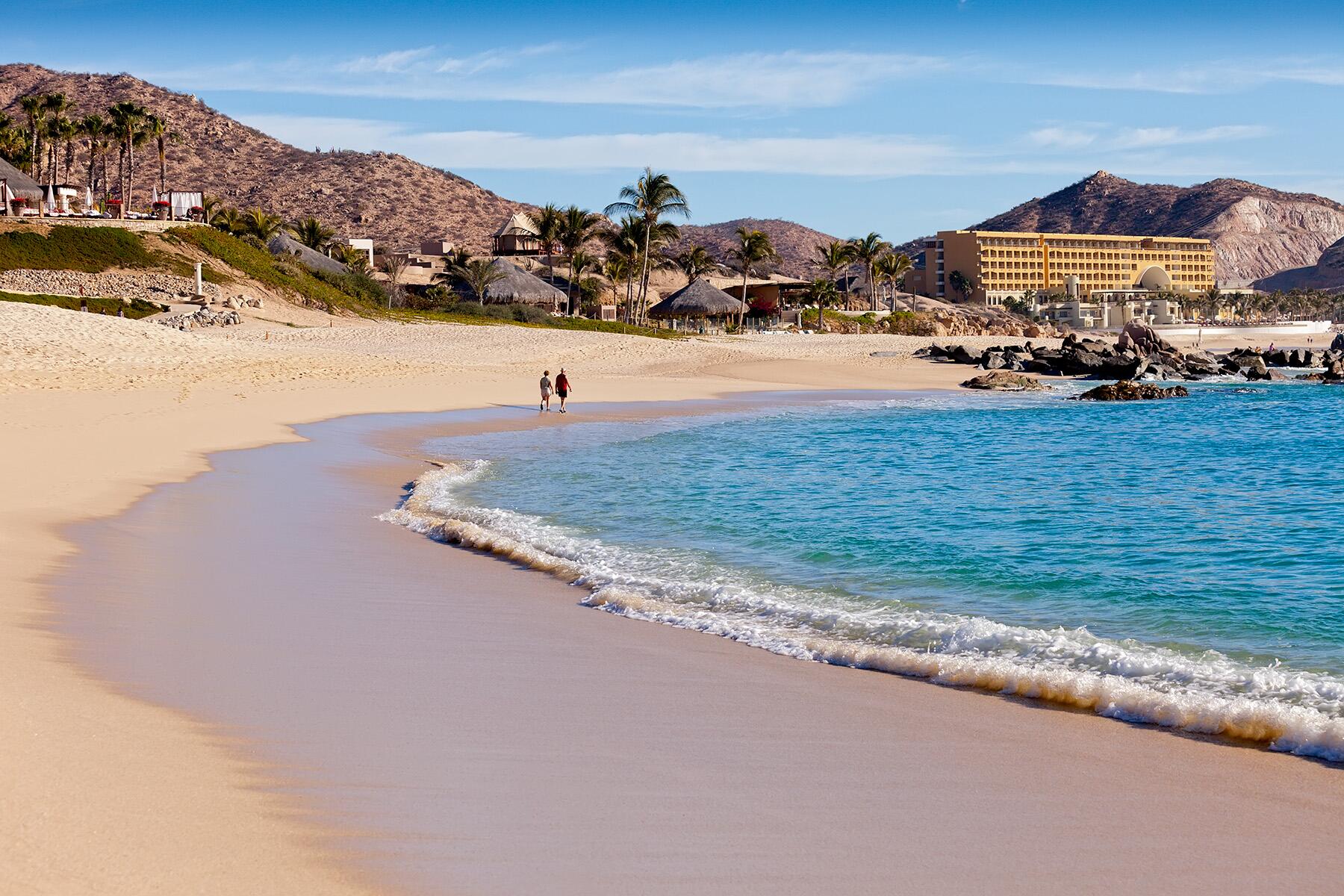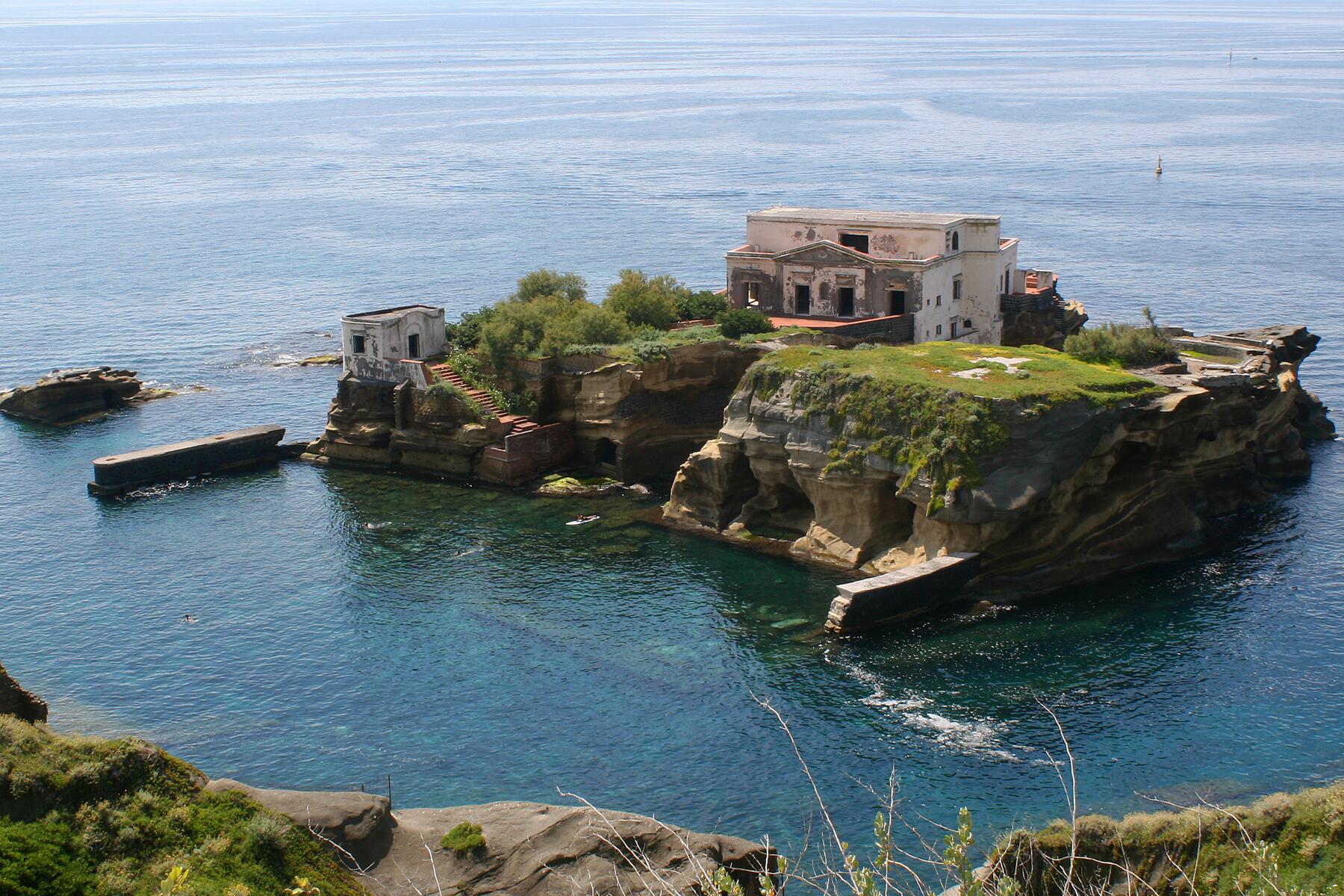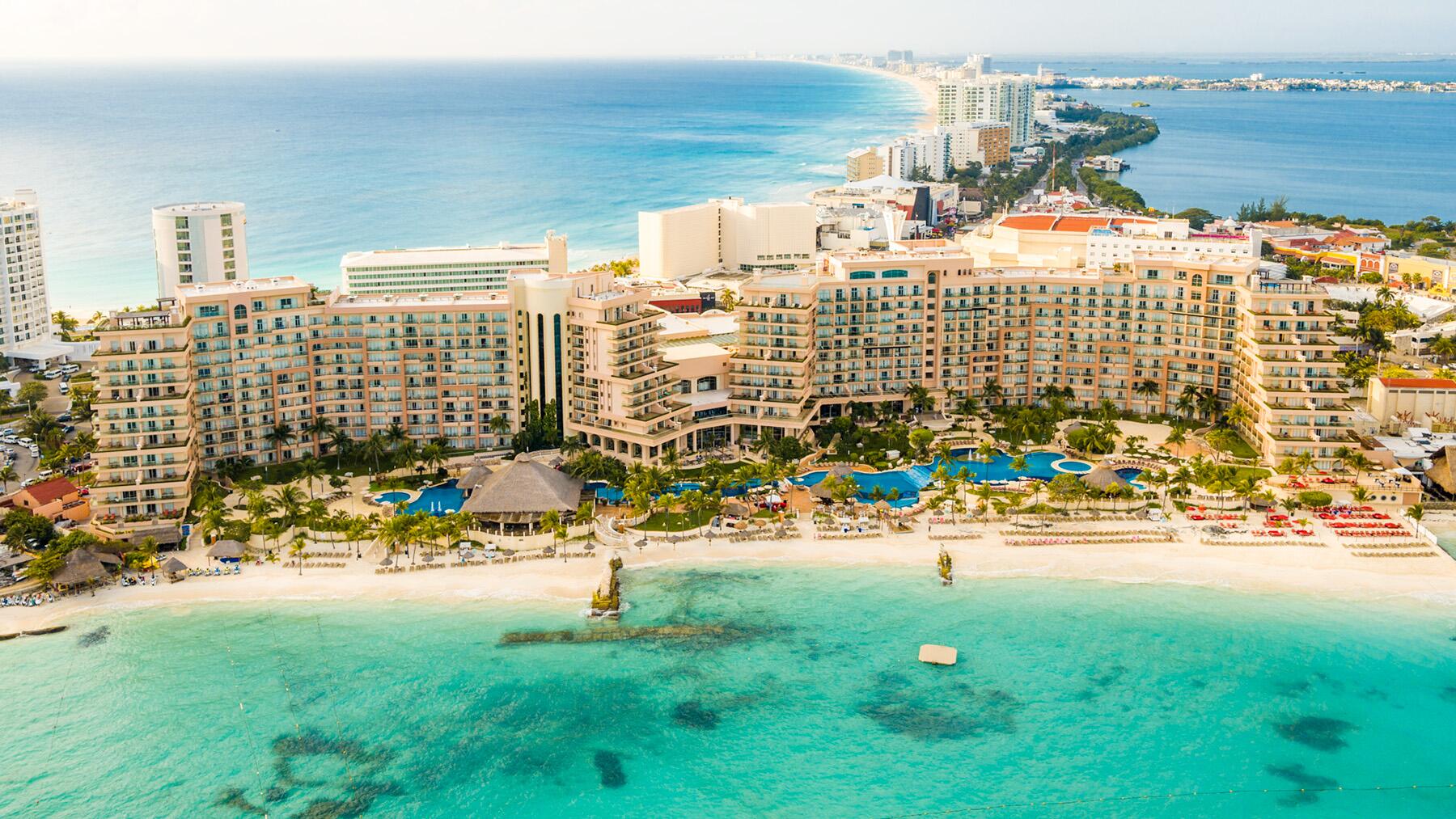How to find waterfront happiness in Cancun, Mexico’s busiest resort town.
A tempting combo of bewitching beaches, shimmering jewel-toned waters, and mild weather keep people coming back to Cancún time and time again. This sun-drenched tropical paradise in the state of Quintana Roo was built for the sole purpose of feel-goodery by a dream team of experts back in the early 1970s. Today, it’s the shiny poster child of the Mexican all-inclusive vacation.
Its very form defies belief. The world-renowned Cancún Hotel Zone (Zona Hotelera) is a long and slender sandbar shaped like a number “7” with postcard-ready white sands that stretch for 14 miles (22.5 kilometers) curving along the Nichupte Lagoon and the Caribbean Sea. 2005’s Hurricane Wilma ravaged these idyllic shores leading authorities to spend $19 million on restoring them to their wide and wonderful glory. In recent years, seasonal deluges of pungent brown seaweed hitting the Mexican Caribbean are now also dealing a blow to the picture-perfect coastal escape. Still, Cancún stands as a playground of endless delight drawing beach fanatics, hedonists, honeymooners, and the like. Here is everything you need to know about Cancún’s beaches.
Recommended Fodor’s Video

How to Access the Beaches in Cancún
Contrary to popular belief, there are no private beaches in Cancún. By law, all beaches in Mexico are public, and any hotels, restaurants, beach clubs, or individuals that erect fences and barriers or hire security guards to restrict entry face fines of up to $47,000 or risk being demolished.
Many resorts in Cancún’s Hotel Zone claim to have private beaches and attempt to block access, but anybody can visit them. You are allowed to simply walk through any hotel lobby to gain beach access, so don’t be deterred by anybody that asks where you’re going. Alternatively, you can take advantage of the beach clubs, restaurants, and public access points scattered along the Hotel Zone.
The Best Time to Visit Cancún’s Beaches
If your primary goal is basking in the sun, there is never a bad time to visit Cancún, as the temperature hovers around 86°F (30°C) all year round. The high season is from December to April, but March—which has low humidity and the least rain—is particularly busy. This is when spring breakers descend in droves, so if you’re more interested in Mayan ruins than margarita-fuelled mayhem, this may not be the month for you. National holidays like Mexican Independence Day (September 16) might also be busy periods.
If you adore spending time in the water, note that sea temperatures are the highest in September and October during the Atlantic Hurricane season, which runs from June to November. For wildlife spotting, majestic whale sharks can be seen around Cancún, Isla Mujeres, and Isla Holbox between May and September.
From April to October, a pungent brown seaweed known as sargassum blankets many of the beaches in the Mexican Caribbean, Cancún included. It might be prudent to avoid these seven months or book your trip for Cancún’s shoulder seasons, which are October through November (crowds are thinner and hotel rates are lower) and April through May (when the sargassum hasn’t yet arrived in earnest).
How to Deal With Sargassum in Cancún
Sargassum (also called sargasso) might interrupt your beach-based activities in Cancún. This is a freely-floating brown seaweed that has been appearing in large amounts in the Caribbean Sea since 2013. Explanations for its prevalence include climate change and pollution from fertilizers and sewage. When the blooms make landfall, they decompose on the shore producing hydrogen sulfide gas which creates a foul smell comparable to eggs rotting.
As beaches are Cancún’s star attraction, the Mexican government, local bodies, resorts, and coastal residents have had to be continuously creative about ways to handle the summertime onslaught in the Yucatán Peninsula. This includes transforming the buoyant macroalgae into building blocks for constructing homes, installing a 9,000-meter anti-sargassum barrier around the entire state of Quintana Roo, and putting brigades of sargaceros on the payroll who are tasked with clearing the beaches each day manually or with heavy machinery so that all is not lost.
Swimming in waters with sargassum is possible, but it can feel itchy on the skin, so the hotel pool is best for highly-inundated days. The northern-facing beaches on the top of the number “7” sandbar of the Hotel Zone tend to be protected from receiving these visually-unappealing mounds, but if you prefer the eastern coast with whiter, finer sand, be sure to select a hotel like JW Marriott Cancun which leads ongoing clean-ups whenever the seaweed accumulates. Monitor Quintana Roo’s sargassum map and Viajefest’s daily report ahead of your trip, and keep an eye on a hotel’s beach cam live feed if one is available.

Hotel Zone Beaches
Cancún’s Hotel Zone has three areas: North Hotel Zone, Middle Hotel Zone, and the South Hotel Zone. The horizontal bar of the number “7” is the North Hotel Zone which faces Bahía de Mujeres and is protected from strong tides by Isla Mujeres, a palm tree-garlanded island 30 minutes from Cancún by ferry. Two noteworthy beaches on this north side are the family-friendly Playa Langosta and Playa Tortugas where the waves are gentle and the party vibes are strong. Playa Pez Volador is the place to turn the volume and the tempo all the way down.
The Middle Hotel Zone and the South Hotel Zone are the vertical part of the number “7” sandbar, representing the upper and lower halves respectively. Currents are stronger on this Caribbean-facing side with ravishing resorts aplenty. The water has more of a turquoise tint on this side.
Playa Delfines (Dolphin Beach) is one of Cancún’s most popular and easily-accessible beaches. Free palapas are available on a first-come, first-served basis, and best of all, dolphins can sometimes be seen frolicking from its “mirador” or lookout point. There is also a Mayan archaeological site (El Rey) a short walk across the street. Choppy waters there mean swimming with little ones isn’t advised but boogie boarders will be content.
For active pursuits and water sports—jet skis, parasailing, banana boats, and surfing—in impossibly blue waters, add Playa Chac Mool and Playa Marlin to your little black book. Snorkelers should reserve a glass bottom boat and snorkeling tour to Punta Nizuc to see the aquatic eye candy and extraordinary underwater statues erected by MUSA (Museo Subacuático de Arte).
Related: Everything to Know About Booking a Stay in Cancún’s Zona Hotelera
Beaches Outside Cancún’s Hotel Zone
Should you choose to venture out of the Hotel Zone, there are equally stunning sandy expanses all around Quintana Roo. To the north of Cancún, Costa Mujeres is quieter with some newer high-rise hotels. Further north is Isla Blanca (White Island), which is actually a thin peninsula loved by kitesurfers.
The areas to the south of Cancún have also burgeoned into veritable paradises for vacationers. Those looking to avoid the Hotel Zone hubbub may find peace and tranquillity in Riviera Cancún. There you can decompress to the max at new and deliciously remote-feeling resorts like Secrets Riviera Cancun Resort & Spa, Royalton Splash Riviera Cancun, and Sensira Resort & Spa. To get away from it all on an island, Isla Contoy, Isla Mujeres, and Cozumel are the gorgeous go-to’s.
Beach Warning Flags
Beach warning flags in Cancún serve as vital indicators of ocean conditions. Take note of what each color represents and respect them when raised. A green flag means you have the green light to swim, snorkel, SUP, and surf to your heart’s content as conditions are optimal and safe. Yellow indicates a need for caution while in the water, and red signals dangerous conditions. A black flag is a stern warning to stay out of the water by all means. Prioritize pool time during such occasions. While on the beaches, stay alert for flag changes, report any emergencies to lifeguards promptly, and always be on the lookout for jet skis and boat traffic.
Sunscreen Requirements in Cancún
When going into cenotes—natural freshwater sinkholes that can be found all around the Yucatán peninsula—wearing sunscreen is not permitted. You might be asked to take a shower before jumping in.
Certain locations in Mexico have bans on sunscreens that aren’t labeled as being reef-safe, biodegradable, or eco-friendly. The gorgeous Garrafon Natural Reef Park 30 minutes from Cancún is one such destination. The Xcaret adventure and theme parks sprinkled across Riviera Maya and Cancún also have sunscreen mandates. Purchase marine-friendly sunblock—lacking chemical ingredients like octinoxate and oxybenzone—before your arrival from brands like Raw Love, Suntegrity, All Good, Pipette, Kokua Sun Care, Reef Repair, and Sun Bum. Pharmacies and Oxxo convenience stores in Cancún’s Hotel Zone may also stock such products.
Related: Cancun’s Airport Has Lots of Scammers. Here’s the Complete Guide to Breezing Through



